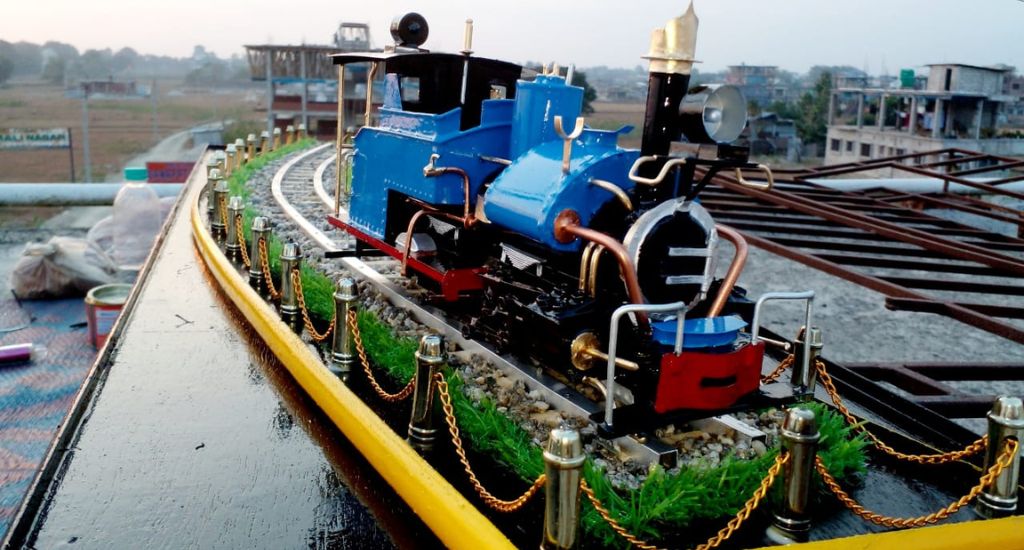
Miniaturist preserves legacy of the Darjeeling toy train
‘In the hills of Darjeeling, the toy train runs in my blood,’ says Sanjeev Bagdas, one of the last remaining artists handcrafting miniature replicas of the iconic Himalayan locomotive

‘In the hills of Darjeeling, the toy train runs in my blood,’ says Sanjeev Bagdas, one of the last remaining artists handcrafting miniature replicas of the iconic Himalayan locomotive
Miniaturist Sanjeev Bagdas meticulously applies strokes of blue paint to a small tin engine. Each movement of his hands reflects a lifetime of dedication and passion, a tribute to the iconic Darjeeling Himalayan Railway (DHR) – a Unesco World Heritage Site.
“For me, it’s about hard work and patience. I have not been to any art school. I am a self-taught artist,” said the 47-year-old from Tindharia, a small town located 22km from Siliguri in northern Bengal. He specialises in creating scale models – miniature replicas, six times smaller – of the heritage locomotive. “The Darjeeling toy train runs in my blood,” he remarked, his voice carrying the weight of two decades spent perfecting his craft.
Sanjeev’s craftsmanship has earned recognition through numerous national exhibitions and prestigious awards. His work has graced the pages of the Continental Modellers’ Club magazine, a renowned publication for train model enthusiasts based in the UK.
Initially, he showcased his models in popular bookshops and railway stations, reaching both tourists and locals alike. “Selling through outlets made my miniatures expensive for buyers because the vendors set their own price, higher than the actual price,” he said.

Despite this, it facilitated broader exposure for his craft and enhanced its popularity. “Majority of buyers are enthusiasts of toy trains or rail models. My models primarily sell through word of mouth, as satisfied customers often refer my work to new potential buyers,” he informed.
His toy train miniatures range in price from Rs 3,000 to Rs 7,000, varying according to size. Regarding the time required, he said each model typically takes at least 4-5 days to complete.
Also Read: We just discovered a hidden gem in Darjeeling
As a child, Sanjeev’s fascination was ignited by the sight of the toy train chugging past his home, a daily spectacle. “How does steam propel a train through the hills of Darjeeling?” he recalled asking his father, Thakur Bagdas.
Guided by his father, a toy train engine technician, Sanjeev embarked on a journey of discovery, unravelling the mysteries of steam-powered locomotion. His curiosity led him to the locomotive workshop of the DHR in his village tucked away in the hills. Tindharia also boasts a colonial-era railway station, serving as a crucial stop on the toy train’s route to Darjeeling. Known for its lush green tea gardens and the awe-inspiring panoramic views of Mount Kanchendzonga, Darjeeling holds a special place in the hearts of both locals and visitors.

Completed in 1881, this British-era railway line stretches approximately 88km in length. It ascends from around 100 metres in New Jalpaiguri to about 2,200 metres in Darjeeling, employing six zigzags and five loops to gain altitude.
During his workshop visits, young Sanjeev closely examined the engine models. “I unknowingly fell in love with the steam engine,” he confessed. Assisted by his father, Sanjeev began crafting miniature train models, particularly focusing on the steam engine.
For more than 22 years, he has dedicated himself to creating DHR models, showcasing his art to both national and international train enthusiasts and miniature collectors. His tin models not only reflect his expertise but also capture the essence of the region’s rich railway heritage.
Each miniature train model is a labour of love, painstakingly crafted by hand, with attention to every intricate detail – from the locomotive to the carriages and the tiny tracks.

Sanjeev’s creations breathe life into the timeless charm of the toy train. The miniature model includes working parts, such as wheels that run on tracks winding through tea gardens made of plastic. “I use simple materials – nuts, bolts, fuse snips, wires, and metal sheets – to bring them to life,” he explained, his hands deftly manoeuvring each component into place. He uses small pebbles and wood chips on the tracks, creating a lifelike appearance.
Also Read: Titanic comes alive as Jahaj Bari in a north Bengal village
“I consider myself fortunate to have studied the blueprint of a steam engine, generously provided by a friend from England,” he said. And to his surprise, “the blueprint was that of the first steam engine (number 779) that operated on the DHR tracks”.
Despite the acclaim and recognition his work has garnered, Sanjeev remains acutely aware of the challenges facing his craft. “There was a time when Tindharia boasted many miniaturists. Today, besides me, there are only a few still actively crafting these models,” he said, his voice tinged with sadness. Today, he stands among a dwindling number of toy train miniaturists in the region, his legacy intertwined with the very fabric of Darjeeling’s heritage.

He persists in practising this fading art form regardless of the limited demand and scarcity of successors to carry on his legacy. His efforts to impart this time-consuming and labour-intensive art form to a handful of young enthusiasts fell through. Many abandoned it midway, citing boredom and tedium. “There’s a lack of interest. Even my son shows little enthusiasm for carrying the legacy forward,” he lamented.
As the sun sets over the mist-shrouded hills of Tindharia, Sanjeev’s workshop stands as a beacon of hope – a testament to the enduring spirit of craftsmanship, the timeless allure of the Darjeeling toy train, and the indomitable spirit of those who dare to keep history alive.
The lead image at the top shows DHR engine miniatures. (Photo by Sanjeev Bagdas)
Diwash Gahatraj is an independent journalist based in Siliguri, West Bengal.